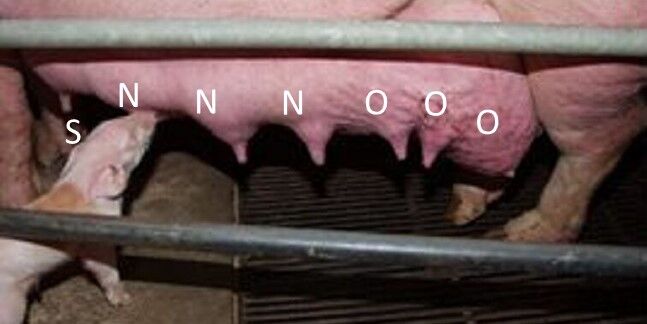
Large litters presuppose that the milk glands are functional at farrowing. It is annoying when a sow farrows many good piglets but cannot nurse all her piglets because of non-functional milk glands. Research shows that this is not an issue with DanBred gilts.

Written by Flemming Thorup, DVM, PhD, Chief Researcher, SEGES Innovation.
Two studies of DanBred gilts, done with 10 years interval, indicate that non-functional milk glands at farrowing are rare with DanBred genetics. Moreover, the research shows that even if milk glands are non-functional at first farrowing or at weaning, they will often become functional again. However, if milk glands remain non-functional at second (or later) farrowings, they will likely continue as such.
A decade apart, consistent results
In 2011, SEGES Innovation studied the milk glands of 207 gilts around the time of mating. A total of 2,858 milk glands were inspected.
A total of 25 milk glands in 11 gilts were rated “inverted”. Seventeen of these glands were retested at weaning of the first litter, and here, 16 of the 17 inverted milk glands were functional. Only five milk glands were rated “non-functional”, when checked before farrowing. Three of these were rated functional by the time the gilts weaned their first litters, giving only two truly non-functional milk glands.
The conclusion was that the true functionality of milk glands cannot be assessed before the gilt has farrowed.
From 2021 to 2023, a similar study was made, and the findings remained consistent. A total of 445 gilts from three different herds were followed from the first farrowing until weaning of the 3rd litter. At the time of farrowing, 6,315 milk glands were inspected and 100 of these glands were rated “non-functional”. However, 50 % of the milk glands recovered and were fully functional by day 21 of lactation. This underlines the findings from 2011: functionality of milk glands in gilts can only be evaluated after the gilt has farrowed and is well into the first lactation.
The study evaluated the same females again in the second and third litter. In the second litter, a total of 90 glands were rated non-functional at farrowing. Some glands recovered, and at day 21 of lactation, a total of 86 milk glands were still evaluated non-functional. With the third litter, only 2 % of the total number of milk glands were rated non-functional. Generally, these 2 % remained non-functional by day 21 after farrowing.
In conclusion: if a milk gland is non-functional after the second litter, it is likely to remain non-functional in the following litters. It is worth noting that in both trials, it was primarily the teats in the middle of the udder that were found to be non-functional.
Check for functioning milk glands and do it at the right time
Functionality of milk glands at second farrowing is more reliable than after first farrowing. Only 28 % of the milk glands that were non-functional at day 21 in first lactation, were also non-functional on day 21 in second lactation. Thus, most of the non-functional milk glands become functional again by next lactation.
Non-functional milk glands are rare in DanBred gilts. Half of the teats rated non-functional around farrowing will be functional later in lactation. So, functionality cannot be evaluated properly until the gilt has started lactating. During lactation some milk glands will lose functionality, as they are not used by a piglet. This will primarily affect the 2nd or 3rd last milk glands, and these teats will often be functional again in the next lactation.
Count number of teats when the coming gilt is weaned. The piglet should lie on the back. This position gives the best overview and assures that the teats protrude clearly. If the piglet is held in the hind legs, the hind teats become anoxic and difficult to see. |
Evaluate the functionality of milk glands after the gilt has farrowed
Suggestion for the rating of the quality of milk glands:
- S = Small
- N = Normal
- O = Out of function

References:
Thorup, F. (2012): Yverets udvikling fra fravænning af sogrisen til første fravænning som so. Trial report no. 938. Danish Pig Research Centre: https://svineproduktion.dk/Publikationer/Kilder/lu_medd/2012/938.aspx#:~:text=938-,Yverets%20udvikling%20fra%20frav%C3%A6nning%20af%20sogrisen%20til%20f%C3%B8rste%20frav%C3%A6nning%20som,15%20funktionelle%20patter%20ved%20faring
Thorup, F. & Nielsen, M.B.F. (2024): Udvikling af soens yver fra første faring til fravænning af fjerde kuld. Trial report no. 1300. SEGES Innovation: https://www.landbrugsinfo.dk/public/e/e/b/management_udvikling_so_yver_forste_faring_fravanning





